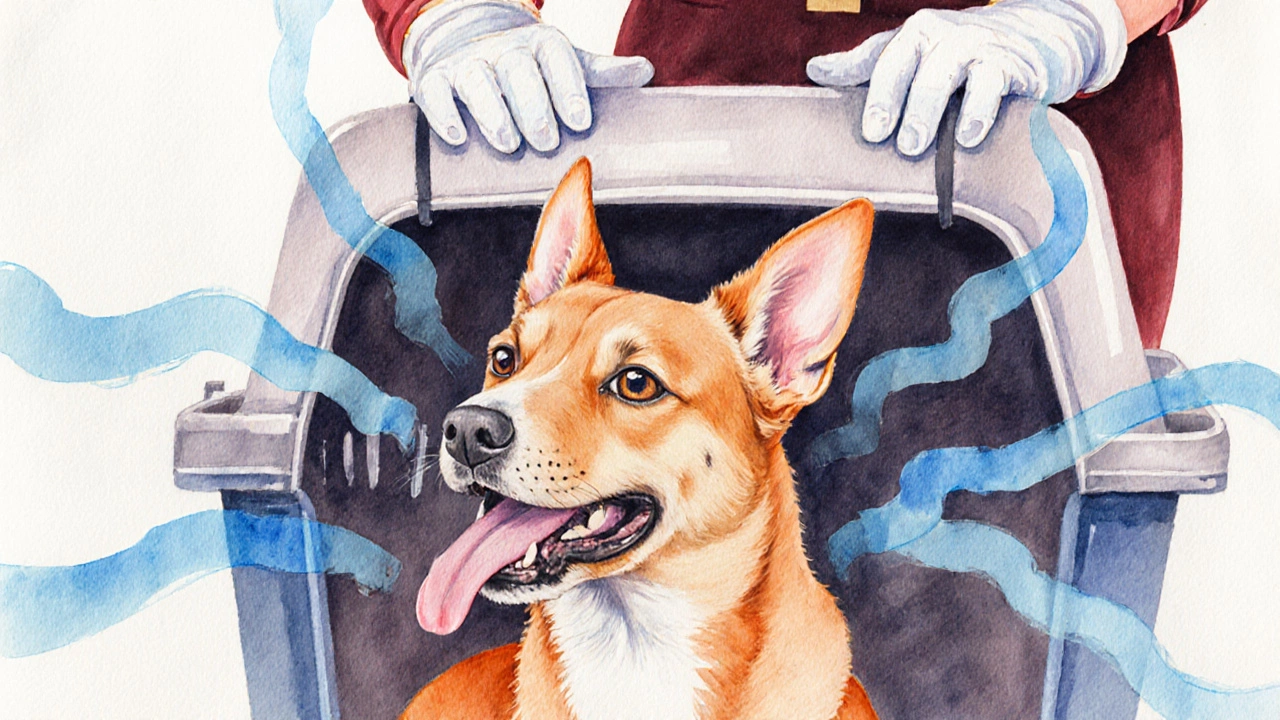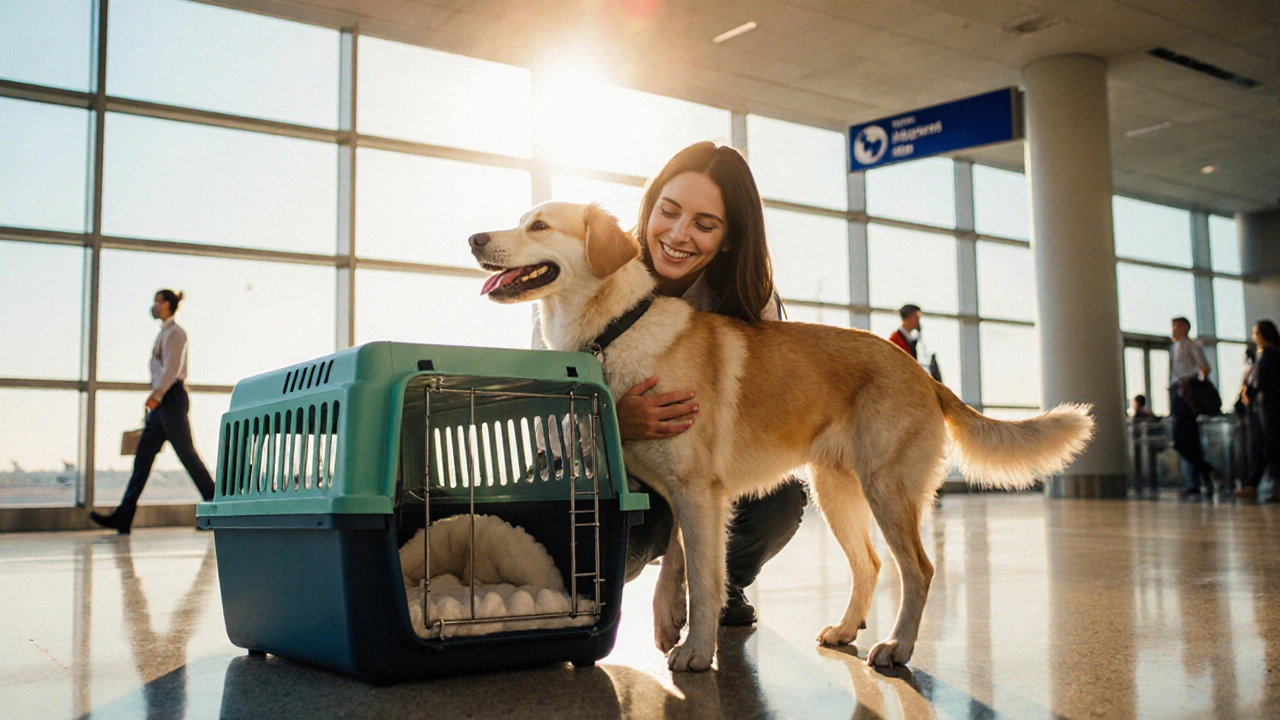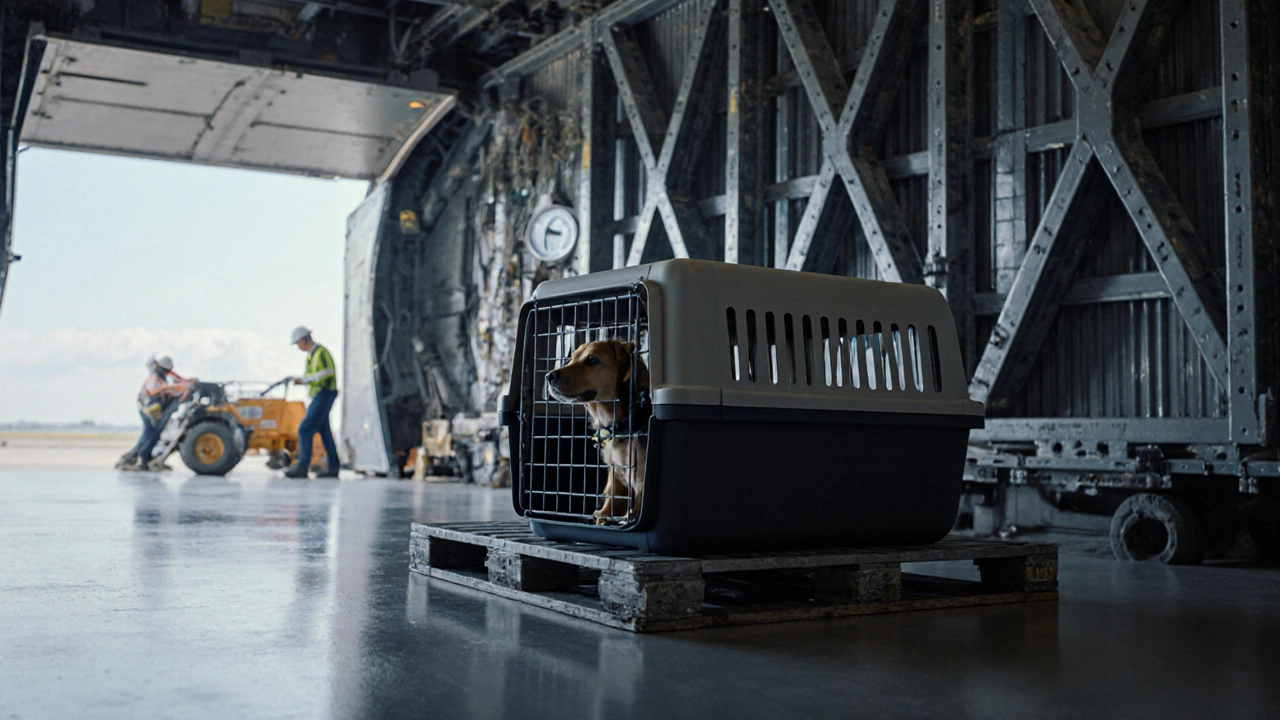Dog Cargo Stress Risk Estimator
This tool estimates stress risk for your dog's cargo flight based on key factors from veterinary guidelines. Enter details below to get personalized safety recommendations.
Enter details to see your dog's stress risk assessment
When you book a Dog Cargo Flight is the process of transporting a dog in the aircraft’s cargo hold rather than in the passenger cabin. Many owners wonder whether this experience feels like a harmless trip or a nightmare for their furry companion. The short answer: it can be stressful, but the level of trauma depends on several controllable factors. Let’s break down what really happens when a dog is shipped in cargo, how you can spot signs of distress, and what steps you can take to keep the journey as calm as possible.
Cargo vs. Cabin: What’s the Real Difference?
First, understand that the cargo hold is not the same as the passenger cabin. It is a temperature‑controlled, pressurized space, but it’s also an area where animals are handled by ground staff, loaded into containers, and placed on a pallet. In contrast, a Cabin Pet Travel allows small dogs to stay in carriers under the seat in front of you
Why does this matter? In the cabin, you can monitor your dog, talk to them, and provide reassurance. In cargo, the dog is alone, depends on the carrier’s ventilation, and is subject to longer handling periods. That isolation is the biggest driver of anxiety for many dogs.
How Stress Shows Up in Dogs During a Cargo Flight
Dogs can’t tell you they’re scared, but they give clear signals. Look for these signs before, during, and after the flight:
- Excessive panting or drooling - a sign of heat stress or anxiety.
- Shaking or trembling - often a physiological response to fear.
- Vocalizations - whining, barking, or howling from the carrier.
- Digestive upset - vomiting or diarrhea can be triggered by cortisol spikes.
- Lethargy or disorientation upon arrival - the dog may be exhausted from the stress.
These behaviors aren’t random; they map directly to the body’s fight‑or‑flight response. The adrenal glands release cortisol, heart rate spikes, and breathing quickens - exactly what you’d see in a dog stuck in traffic during a thunderstorm.
Key Factors That Can Turn a Simple Trip Into a Traumatic Event
Several variables amplify the stress level of a cargo flight. Understanding them helps you mitigate risk.
| Factor | Impact Level | Typical Mitigation |
|---|---|---|
| Temperature Extremes | High | Choose airlines with certified climate control, avoid summer months. |
| Length of Flight | Medium‑High | Break up long journeys with stop‑overs when possible. |
| Handling Quality | Variable | Use reputable freight companies and request gentle handling. |
| Carrier Comfort | Medium | Choose a well‑ventilated, airline‑approved carrier with padding. |
| Pre‑flight Anxiety | Low‑Medium | Acclimate the dog to the carrier weeks before departure. |
Temperature is often the biggest culprit. Even though cargo holds are pressurized, they can still swing between 45 °F (7 °C) and 85 °F (29 °C) depending on the aircraft and the season. Dogs that are brachycephalic (short‑nosed breeds) are especially vulnerable to heat.

Airline Live Animal Regulations set by the International Air Transport Association (IATA) and enforced by national agencies like the USDA
Most major carriers follow the IATA Live Animal Regulations (LAR). These rules dictate carrier dimensions, ventilation requirements, and minimum temperature thresholds. However, enforcement can vary. Always verify that the airline you choose has a dedicated pet‑care team and a track record of safe cargo transports.
Some airlines offer a “Pet First” program that adds extra monitoring, while others bundle cargo handling with regular freight, which can increase the chance of rough treatment. Research the airline’s pet‑specific policies - a quick Google search for “airline name cargo pet policy 2025” usually yields the latest details.
Preparing Your Dog for a Cargo Flight
Preparation starts weeks before the ticket is booked.
- Veterinary Clearance: Get a health certificate within 10 days of travel. The vet should confirm the dog is up to date on vaccinations, free of contagious diseases, and fit for travel.
- Acclimation to the Carrier: Let your dog explore the carrier at home. Place a favorite blanket and a chew toy inside. Short, positive sessions help the dog view the carrier as a safe den.
- Hydration and Feeding: Feed a light meal 4‑6 hours before drop‑off, but skip the water 2 hours prior to avoid accidents.
- Pre‑flight Exercise: A brisk walk or play session burns excess energy and reduces anxiety.
- Documentation: Include the health certificate, vaccination records, and a copy of the airline’s pet policy in the carrier’s exterior pouch.
Don’t forget a small amount of water in a sealed bottle that can be accessed if the flight is unusually long. Some owners attach a squeeze‑bottle to the carrier’s side for emergencies.

Real‑World Stories: What Dog Owners Have Experienced
Sarah from Denver flew her 30‑lb Labrador, Buddy, on a cargo flight to California. Buddy arrived calm, wagging his tail, because Sarah chose a spring‑season flight, a carrier with extra ventilation, and a airline that offered a “pet‑monitoring” service. In contrast, Mark from Texas shipped his 12‑lb French Bulldog, Coco, during a heatwave. Coco showed severe panting and dehydration on arrival, requiring a vet visit. Mark learned that brachycephalic breeds are especially at risk in warm cargo holds.
These anecdotes illustrate that the same process can have very different outcomes based on timing, breed, and preparation.
Quick Checklist: Safe Cargo Travel for Your Dog
- Confirm airline follows IATA Live Animal Regulations.
- Book flights during cooler months or choose airlines with climate‑controlled holds.
- Obtain a recent veterinary health certificate.
- Use an airline‑approved carrier that meets size and ventilation standards.
- Acclimate your dog to the carrier over several weeks.
- Provide a light meal and limit water intake before drop‑off.
- Attach a copy of all documents to the carrier’s exterior.
- Stay in touch with the airline’s pet‑care desk on the day of travel.
Follow this list and you’ll drastically cut the odds of a traumatic experience.
Frequently Asked Questions
Can I bring my dog in the cabin instead of cargo?
If your dog fits under the seat (typically under 15‑17 lb) and the airline allows cabin pets, that’s the safest option because you can monitor them directly.
What temperature range is safe for dogs in cargo?
Most airlines keep cargo between 45 °F (7 °C) and 85 °F (29 °C). Aim for flights where the projected temperature stays below 75 °F, especially for short‑nosed breeds.
How long can a dog stay in a cargo hold?
There’s no hard limit, but stress rises sharply after 6‑8 hours. If you need a longer trip, consider a stop‑over with a layover that allows the dog to be taken out and exercised.
Do airlines provide any monitoring for cargo pets?
A few carriers offer a pet‑monitoring service that places a temperature sensor in the crate and notifies staff if it goes out of range. Check the airline’s website for “pet‑first” or similar programs.
What should I do if my dog shows signs of distress after landing?
Contact a local vet immediately. Bring the health certificate, flight details, and the carrier’s documentation. Early treatment can prevent dehydration or heatstroke complications.
Flying your dog in cargo isn’t automatically a nightmare, but it does demand careful planning. By choosing the right airline, respecting temperature limits, and giving your dog a comfortable, familiar carrier, you can turn a potentially stressful trip into a smooth ride. Remember, the goal is to minimize the unknown - and the unknown is what makes most dogs anxious. With the right steps, you’ll give your pup the best possible chance to arrive happy and healthy.
